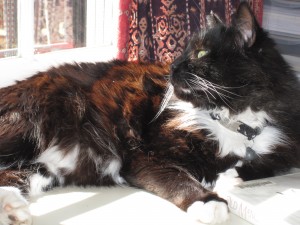 Due to domestic pressure, I’ve wanted to do a post on cats of the Civil War. I tried, but came up with only one feline of note: Tom Cat, the Rebel mascot of Fort McAllister. Tom is honored with a historical marker in Georgia, and his full story is told here. Other than old Tom, it seems, dogs ruled the day.
Due to domestic pressure, I’ve wanted to do a post on cats of the Civil War. I tried, but came up with only one feline of note: Tom Cat, the Rebel mascot of Fort McAllister. Tom is honored with a historical marker in Georgia, and his full story is told here. Other than old Tom, it seems, dogs ruled the day.
Except for the Maine Coon. “It was during the 1860s that farmers would tell stories and brag about the powers and intelligence of their Maine Coons. During this decade these same farmers began having their own cat show at the Skowhegan Fair where Maine Coons from all over the territory competed for the title ‘Maine State Champion Coon Cat.'”
Many myths adhere to the origins of the Maine Coon. The one I prefer is that they began as seafaring cats, belonging to an English Captain Charles Coon. When the Captain went ashore, so did his long-haired hearties. Those who jumped ship married into the hardy local population and became America’s “first indigenous show cat.”
The Maine Coon’s fur is as luxurious as a cat’s can be, and a felt-like undercoat gives them an extra layer of warmth. In spring, a Maine Coon can literally seem to lose weight as the thick winter coat is exchanged for summer. Little tufts of fur between toes and paw pads are very appealing, as are the ear tufts.
I can’t boast that our cat is a pure-bred Maine Coon. Like me, he’s mixed: part pure Northern and part pure Southern, not to mention a sea-faring side (in my case, Venetian). And like me he’s spent the majority of his adult years in Virginia.
Well, I hope he’s happy now. Though he probably won’t like sharing a page with another cat, Johnny, Billy, or Tom.